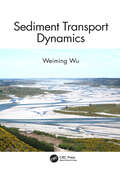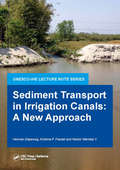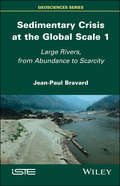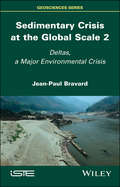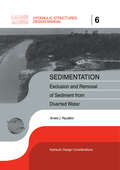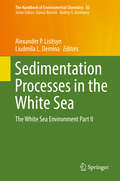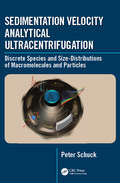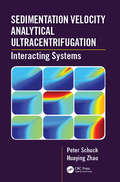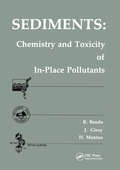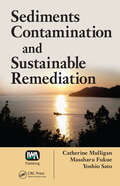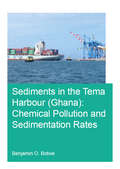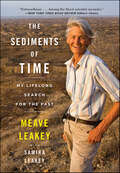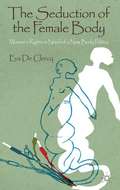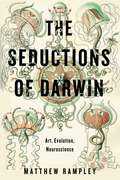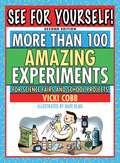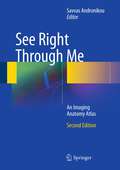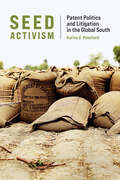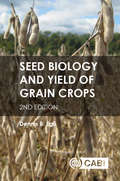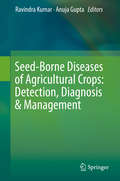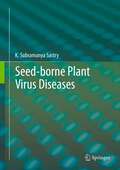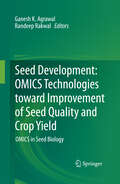- Table View
- List View
Sediment Transport Dynamics
by Weiming WuThis book focuses on the fundamentals of sediment transport in surface waters. It covers sediment properties, open channel flows, sediment particle settling, incipient motion, bed forms, bed load, suspended load, total load, cohesive sediments, water-sediment two-phase flows, hyperconcentrated flows, debris flows, wave-induced sediment transport, turbidity currents, and physical modeling. Besides the primary context of river sedimentation, this book extensively covers sediment transport under coexisting waves and currents in coasts and estuaries, hyperconcentrated and debris flows in rivers, as well as turbidity currents in lakes, reservoirs, channels, and the ocean. It includes a chapter on the water-sediment two-phase flow theory, which is considered the basis of many sediment transport models. It introduces some special topics have that emerged in recent years, such as the transport of mixed cohesive and noncohesive sediments, biofilm-coated sediments, and infiltrated sand within gravel and cobble beds. The text merges classical and new knowledge of sediment transport from various sources in English and non-English literature and includes important contributions made by many scientists and engineers from all over the world. It balances the breadth, depth, fundamental importance, practical applicability, and future advancement of the covered knowledge, and can be used as a text and reference book. The chapters are arranged in a useful sequence for teaching purposes. Certain homework problems are prepared, which also highlight the important topics for instructors to select. Solutions to homework problems are available from the author by request.
Sediment Transport in Irrigation Canals: A New Approach (IHE Delft Lecture Note Series)
by Herman Depeweg Krishna P. Paudel Néstor Méndez VSediment transport in irrigation canals influences to a great extent the sustainability of an irrigation system. Unwanted erosion or deposition will not only increase maintenance costs, but may also lead to unfair, unreliable and unequitable distribution of irrigation water to the end users. Proper knowledge of the characteristics, including behaviour and transport of sediment will help to design irrigation systems, plan effi cient and reliable water delivery schedules, to have a controlled deposition of sediments, to estimate and arrange maintenance activities, etc. The main aim of these lecture notes is to present a detailed analysis and physical and mathematical descriptions of sediment transport in irrigation canals and to describe the mathematical model SETRIC that predicts the sediment transport, deposition and entrainment rate as function of time and place for various flow conditions and sediment inputs. The model is typically suited for the simulation of sediment transport under the particular conditions of non-wide irrigation canals where the flow and sediment transport are strongly determined by the operation of the flow control structures. The lecture notes will contribute to an improved understanding of the behaviour of sediments in irrigation canals. They will also help to decide on the appropriate design of the system, the water delivery plans, to evaluate design alternatives and to achieve an adequate and reliable water supply to the farmers.
Sedimentary Crisis at the Global Scale 1: Large Rivers, From Abundance to Scarcity
by Jean-Paul BravardThe Earth’s oceans are currently undergoing unprecedented changes: rivers have suffered a severe reduction in their sediment transport, and as a result, sediment input to the oceans has dropped lower than ever before. These inputs have varied over millennia as a result of both natural occurrences and human actions, such as the building of dams and the extraction of materials from riverbeds. Sedimentary Crisis at the Global Scale 1 examines how river basins have been affected by the sedimentary crises of various historical epochs. By studying global balances, it provides insights into the profound disruption of the solid transport of fluvial bodies. The book also explores studies of various rivers, from the Amazon, which remains relatively unaffected, to dying rivers such as the Colorado and the Nile.
Sedimentary Crisis at the Global Scale 2: Deltas, A Major Environmental Crisis
by Jean-Paul BravardThe great deltas of the globe have been threatened for several decades but their decline now appears to be inevitable; they are receding and losing the fertility that supports their tens of millions of inhabitants. Our deltas are victims of the dramatic deterioration in the volume of continental sediment brought by rivers to the oceans.By nature, deltas are fragile eco- and geological organisms. For centuries, they have been subject to human actions in the Mediterranean and European world, and today a deep crisis is affecting the great tropical deltas. A chapter is also devoted to concerns facing the Mississippi, an “aging delta of the new world”.Sedimentary Crisis at the Global Scale 2 discusses possible strategies to protect the deltas of the world – or at least adapt them and their dependencies to the changes they face. Several models are possible, including comprehensive protection (such as in the Netherlands) and cautious and respectful opening to the forces of the oceans in an environment-first perspective.
Sedimentation: Exclusion and Removal of Sediment from Diverted Water (Iahr Design Manual Ser. #6)
by Arved J. RaudkiviThis monograph provides the practising engineer with a concise overview of the methods of water diversion and exclusion or removal of sediment from the diverted water. The emphasis is on flow features and the associated conveyance of sediments.
Sedimentation Processes in the White Sea: The White Sea Environment Part II (The Handbook of Environmental Chemistry #82)
by Alexander P. Lisitsyn Liudmila L. DeminaThis book presents a new perspective on the sedimentation processes in the White Sea, based on a multidisciplinary research study conducted between 2001 and 2016. It provides a comprehensive review and discusses the latest research findings on the ecosystem of this sub-arctic zone.The topics addressed include suspended particulate matter as a main source and proxy of the sedimentation processes in the White Sea; vertical fluxes of dispersed sedimentary matter and absolute masses in the White Sea; and the development history and quaternary deposits of the modern White Sea basin. The authors closely examine the abundance and species composition of microalgae associations and the environmental conditions in the bottom sediments of the White Sea, namely, heavy metal accumulation and aliphatic and polycyclic aromatic hydrocarbons. The book ends contain a summary of the key conclusions and recommendations. Together with the companion volume Biogeochemistry of the Atmosphere, Ice and Water of the White Sea: The White Sea Environment Part I, it offers an essential source of information for postgraduate students, researchers, and stakeholders alike.
Sedimentation Velocity Analytical Ultracentrifugation: Discrete Species and Size-Distributions of Macromolecules and Particles
by Peter SchuckA follow-up to the experimental and instrumental aspects described in Basic Principles of Analytical Ultracentrifugation, the volume Sedimentation Velocity Analytical Ultracentrifugation: Discrete Species and Size-Distributions of Macromolecules and Particles describes the theory and practice of data analysis. Mathematical models for the sedimentation process and the evolution of detected signals are developed in a comprehensive framework, jointly with the description of current and historical strategies for how to extract from noisy experimental data the physical parameters of interest, such as size, mass, and shape, composition, and polydispersity of sedimenting particles. The methods are extensively illustrated, and supported with practical applications, as well as cross-references where to find the methods in the public domain software SEDFIT and SEDPHAT. The systems covered are discrete or polydisperse mixtures of sedimenting molecules or particles in dilute solution, such as proteins and other biomolecules and their stable complexes, man-made polymers, and nanoparticles, observed in different optical systems. A useful reference for researchers and graduate students of macromolecular disciplines, these methods form the essential foundation for the analysis of dynamic interacting systems, which are covered in the volume Sedimentation Velocity Analytical Ultracentrifugation: Interacting Systems. Software referenced in the book is available for download at: https://sedfitsedphat.nibib.nih.gov/default.aspx
Sedimentation Velocity Analytical Ultracentrifugation: Interacting Systems
by Peter Schuck Huaying ZhaoAnalytical ultracentrifugation is one of the most powerful solution techniques for the study of macromolecular interactions, to define the number and stoichiometry of complexes formed, and to measure affinities ranging from very strong to very weak and repulsive. Building on the data analysis tools described in the volume Sedimentation Velocity Analytical Ultracentrifugation: Discrete Species and Size-Distributions of Macromolecules and Particles, and the experimental and instrumental aspects in the first volume Basic Principles of Analytical Ultracentrifugation, the present volume Sedimentation Velocity Analytical Ultracentrifugation: Interacting Systems is devoted to the theory and practical data analysis of dynamically coupled sedimentation processes. This volume is designed to fill a gap in biophysical methodology to provide a framework that builds on the fundamentals of the highly developed traditional methods of analytical ultracentrifugation, updated with current methodology and from a viewpoint of modern applications. It will be an invaluable resource for researchers and graduate students interested in the application of analytical ultracentrifugation in the study of interacting systems, such as biological macromolecules, multi-protein complexes, polymers, or nanoparticles.
Sediments: Chemistry and Toxicity of In-Place Pollutants
by Renato BaudoThis important volume-the product of a meeting of a select group of scientists-provides the most recent research results from the world's leaders in the study of toxic pollutants in sediments.It gives practical information on measuring and mapping distributions of concentrations of pollutants and their toxic effects in sediments. Also covered are the use and relative advantages and disadvantages of benthic chambers, sedimentation traps, box corers, "peepers" and other sampling techniques in sediment research and assessment.Important topics covered include: bioassay, elemental speciation, diffuse source problems, nutrient flux, biomethylation, bioavailability, and toxicity assessment.Will help in assessment and monitoring of chemistry, dynamics, bioavailability, and toxicity of pollutants, as well helping to chart courses for remedial action.This book will be of interest to anyone interested in the processes controlling the chemistry and movement of pollutants in sediments, especially:limnologistsaquatic toxicologistsengineerslake managersecologistsbiologistsenvironmental chemists
Sediments Contamination and Sustainable Remediation
by Catherine N. Mulligan Masaharu Fukue Yoshio SatoAlthough valuable resources in river basins and other aqueous environments, sediments often receive much less attention from researchers, policymakers, and other professionals than other components of the ecosystem. Until now. Highlighting the important role that sediments play in the geoenvironment, Sediments Contamination and Sustainable Remediat
Sediments in the Tema Harbour: Chemical Pollution and Sedimentation Rates (IHE Delft PhD Thesis Series)
by Benjamin O. BotweSediment pollution and accumulation in harbours are major environmental issues and studies that advance their solutions are essential for harbour sustainability. This book provides the first comprehensive assessment of chemical pollution in sediments and sediment accumulation rates in the tropical Tema Harbour (Ghana). This book contributes to improving our ability to use an integrated approach involving sediment chemistry and bioassays in one comprehensive assessment of the contamination state of a tropical coastal environment. Whole-sediment toxicity bioassays using the amphipod Corophium volutator and the polychaete Hediste diversicolor as bioindicators were combined with data on concentrations of total metal and metal binding forms, radionuclides, organochlorine pesticides and polycyclic aromatic hydrocarbons in bottom sediments as well as total metal concentrations in settling silt-clay particles collected by sediment traps to characterise the hazard, risk and impact of sediments from the tropical coastal Tema Harbour.
The Sediments of Time: My Lifelong Search for the Past
by Meave Leakey Samira Leakey"Extraordinary . . . This inspirational autobiography stands among the finest scientist memoirs." —New York Times Book Review, Editors' ChoiceMeave Leakey&’s thrilling, high-stakes memoir—written with her daughter Samira—encapsulates her distinguished life and career on the front lines of the hunt for our human origins, a quest made all the more notable by her stature as a woman in a highly competitive, male-dominated field. In The Sediments of Time, preeminent paleoanthropologist Meave Leakey brings us along on her remarkable journey to reveal the diversity of our early pre-human ancestors and how past climate change drove their evolution. She offers a fresh account of our past, as recent breakthroughs have allowed new analysis of her team&’s fossil findings and vastly expanded our understanding of our ancestors. Meave&’s own personal story is replete with drama, from thrilling discoveries on the shores of Lake Turkana to run-ins with armed herders and every manner of wildlife, to raising her children and supporting her renowned paleoanthropologist husband Richard Leakey&’s ambitions amidst social and political strife in Kenya. When Richard needs a kidney, Meave provides him with hers, and when he asks her to assume the reins of their field expeditions after he loses both legs in a plane crash, the result of likely sabotage, Meave steps in. The Sediments of Time is the summation of a lifetime of Meave Leakey&’s efforts; it is a compelling picture of our human origins and climate change, as well as a high-stakes story of ambition, struggle, and hope."A fascinating glimpse into our origins. Meave Leakey is a great storyteller, and she presents new information about the far off time when we emerged from our ape-like ancestors to start the long journey that has led to our becoming the dominant species on Earth. That story, woven into her own journey of research and discovery, gives us a book that is informative and captivating, one that you will not forget."—Jane Goodall, PhD, DBE, Founder of the Jane Goodall Institute
The Seduction of the Female Body
by Eva De ClercqDrawing on the ambiguous meaning of the notion of vulnerability, the book offers an innovative approach to the topic of the female body in relation to women's rights; going beyond the age-old dichotomy of casting women as either passive victims or conscious agents.
The Seductions of Darwin: Art, Evolution, Neuroscience
by Matthew RampleyThe surge of evolutionary and neurological analyses of art and its effects raises questions of how art, culture, and the biological sciences influence one another, and what we gain in applying scientific methods to the interpretation of artwork. In this insightful book, Matthew Rampley addresses these questions by exploring key areas where Darwinism, neuroscience, and art history intersect.Taking a scientific approach to understanding art has led to novel and provocative ideas about its origins, the basis of aesthetic experience, and the nature of research into art and the humanities. Rampley’s inquiry examines models of artistic development, the theories and development of aesthetic response, and ideas about brain processes underlying creative work. He considers the validity of the arguments put forward by advocates of evolutionary and neuroscientific analysis, as well as its value as a way of understanding art and culture. With the goal of bridging the divide between science and culture, Rampley advocates for wider recognition of the human motivations that drive inquiry of all types, and he argues that our engagement with art can never be encapsulated in a single notion of scientific knowledge.Engaging and compelling, The Seductions of Darwin is a rewarding look at the identity and development of art history and its complicated ties to the world of scientific thought.
The Seductions of Darwin: Art, Evolution, Neuroscience
by Matthew RampleyThe surge of evolutionary and neurological analyses of art and its effects raises questions of how art, culture, and the biological sciences influence one another, and what we gain in applying scientific methods to the interpretation of artwork. In this insightful book, Matthew Rampley addresses these questions by exploring key areas where Darwinism, neuroscience, and art history intersect.Taking a scientific approach to understanding art has led to novel and provocative ideas about its origins, the basis of aesthetic experience, and the nature of research into art and the humanities. Rampley’s inquiry examines models of artistic development, the theories and development of aesthetic response, and ideas about brain processes underlying creative work. He considers the validity of the arguments put forward by advocates of evolutionary and neuroscientific analysis, as well as its value as a way of understanding art and culture. With the goal of bridging the divide between science and culture, Rampley advocates for wider recognition of the human motivations that drive inquiry of all types, and he argues that our engagement with art can never be encapsulated in a single notion of scientific knowledge.Engaging and compelling, The Seductions of Darwin is a rewarding look at the identity and development of art history and its complicated ties to the world of scientific thought.
See for Yourself!: More Than 100 Amazing Experiments for Science Fairs and School Projects
by Vicki CobbWith See For Yourself, budding scientists can wow their teachers and classmates (and maybe win a ribbon or two) by learning How to extract DNA from an onion How pigments from vegetables make dye How to make paper out of lint from a clothes dryer How to make a friend feel like he or she has a third hand What happens when you grow yeast in dandruff shampoo That tea and iron pills make excellent inks And much more! See for Yourself includes experiments in the areas of chemistry, earth science, physical science, the human body, and technology, but the experiments all take their inspiration from very familiar places. The materials needed to execute the experiments can all be inexpensively purchased at the supermarket, the toy store, the hardware store, the stationery store, and the drugstore. Some of the experiments are quick and easy, while others are more challenging. Most include additional suggestions so that curious young scientists can keep on investigating.
See How They Grow: Farm (See How They Grow)
by DKLet your little one follow their favorite baby animals as they grow and change! Go on a farm adventure like no other! Along the way, you&’ll meet a little lamb, a darling duckling, a playful piglet, and more in this adorable introduction to animal life stages. If there&’s one thing kids can&’t get enough of, it&’s baby animals. In this series of three engaging children&’s books, baby farm animals come to life through exquisite, crisp photography that shows the early stages of their lives. From a helpless newborn to a confident, curious creature on the cusp of adulthood, this charming animal book captures in beautiful detail how farm animals grow and develop. Perfect for children aged 3–5 years, See How They Grow: Farm will instill a lifelong love of animals, nature, and reading.Ready, Set, Grow! A series of clear photographs show the same animal at several different stages in its early life. Your child can discover how a chick hatches from its egg and how a duckling&’s feathers turn from yellow to white. Packed with fun facts and easy-to-follow text, this nature book is ideal for reading aloud and developing your child&’s vocabulary. This activity book provides lots of opportunities for parent-and-child interaction and hours of farm animal fun! It&’s the ultimate bedtime storybook for little animal-lovers. Complete the Series:Let your budding zoologist discover how other wonderful animals grow and change! Look out for more titles in this elegant series from DK Books such as See How They Grow: Pets, See How They Grow: Woodland Animals, and See How They Grow: Zoo Animals.
See How They Grow Pets (See How They Grow)
by DKLet your little nature lover follow their favorite animals as they grow and change in the first weeks and months of their lives.This children&’s picture book is a must for fans of cute pets! Your child will meet a lovable puppy, a fluffy kitten, a delightful baby rabbit and many more in this charming introduction to animal life stages. Perfect for preschool children ages 3-5, this adorable animal book captures in beautiful detail how animals grow and develop. It's packed with: • Five different young animals at different stages of their early lives. • Beautiful photography and text that will help instill a lifelong love of animals, nature and books. • &“Puppy&” spreads that feature brand-new photography. Ready, set, grow! This wonderful activity book brings baby animals to life through beautiful, crisp photography. It follows them through their early lives — from helpless newborns to confident, curious creatures on the cusp of adulthood. See a bunny growing fur, kittens learning to hunt and a puppy playing with toys.Packed with fun facts and delightful read-aloud text, this nature book is ideal for developing your child's vocabulary. It has lots of opportunities for parent-and-child interaction and hours of baby animal fun! It's the ultimate bedtime storybook for little animal lovers.Your budding zoologist can discover how other wonderful animals grow too! Look out for more titles in this elegant series of children&’s educational books from DK like See How They Grow Kitten, See How They Grow Bunny/Rabbit, and See How They Grow Pony/Foal.
See It with a Small Telescope: 101 Cosmic Wonders Including Planets, Moons, Comets, Galaxies, Nebulae, Star Clusters and More
by Will KalifHave Fun Exploring the Stars with Close-up Views of Space Objects Right from Your Own BackyardTake the mystery and struggle out of discovering new worlds. With hands-on tips, tricks and instructions, this book allows you to unleash the full power of your small telescope and view amazing space objects right from your own backyard, including:• Saturn&’s Rings• Jupiter&’s Moons• Apollo 11's Landing Site• Orion Nebula• Andromeda Galaxy• Polaris Double Star• Pegasus Globular Cluster• And much, much more!
See Right Through Me
by Savvas AndronikouThis atlas demonstrates all components of the body through imaging, in much the same way that a geographical atlas demonstrates components of the world. Each body system and organ is imaged in every plane using all relevant modalities, allowing the reader to gain knowledge of density and signal intensity. Areas and methods not usually featured in imaging atlases are addressed, including the cranial nerve pathways, white matter tractography, and pediatric imaging. As the emphasis is very much on high-quality images with detailed labeling, there is no significant written component; however, 'pearl boxes' are scattered throughout the book to provide the reader with greater insight. This atlas will be an invaluable aid to students and clinicians with a radiological image in hand, as it will enable them to look up an exact replica and identify the anatomical components. The message to the reader is: Choose an organ, read the 'map,' and enjoy the journey!
Seed Activism: Patent Politics and Litigation in the Global South (Food, Health, and the Environment)
by Karine E. PeschardHow lawsuits around intellectual property in Brazil and India are impacting the patentability of plants and seeds, farmers&’ rights, and the public interest.Over the past decade, legal challenges have arisen in the Global South over patents on genetically modified crops. In this ethnographic study, Karine E. Peschard explores the effects of these disputes on people&’s lives, while uncovering the role of power—material, institutional, and discursive—in shaping laws and legal systems. The expansion of corporate intellectual property (IP), she shows, negatively impacts farmers&’ rights and, by extension, the right to food, since small farms produce the bulk of food for domestic consumption. Peschard sees emerging a new legal common sense concerning the patentability of plant-related inventions, as well as a balance among IP, farmers&’ rights, and the public interest.Peschard examines the strengthening of IP regimes for plant varieties, the consolidation of the global biotech industry, the erosion of agrobiodiversity, and farmers&’ dispossession. She shows how litigants question the legality of patents and private IP systems implemented by Monsanto for royalties on three genetically modified crop varieties, Roundup Ready soybean in Brazil and Bt cotton and Bt eggplant in India. Peschard argues that these private IP systems have rendered moot domestic legislation on plant variety protection and farmers&’ rights. This unprecedented level of corporate concentration in such a vital sector raises concerns over the erosion of agricultural biodiversity, farmers&’ rights and livelihoods, food security, and, ultimately, the merits of extending IP rights to higher life forms such as plants.
Seed Biology and Yield of Grain Crops
by Dennis EgliThis new edition of an established title examines the determination of grain crop yield from a unique perspective, by concentrating on the influence of the seed itself. As the food supply for an expanding world population is based on grain crops harvested for their seeds, understanding the process of seed growth and its regulation is crucial to our efforts to increase production and meet the needs of that population. Yield of grain crops is determined by their assimilatory processes such as photosynthesis and the biosynthetic processes in the seed, which are partly regulated within the seed itself. Providing a timely update in this field and highlighting the impact of the seed on grain crop yields, this book: · Describes all aspects of seed growth and development, including environmental and genetic effects on growth rate and length of the filling period. · Discusses the role of the seed in determining the two main yield components: individual seed weight and number of seeds per unit area. · Uses the concepts and models that have been developed to understand crop management and yield improvement. Substantially updated with new research and further developments of the practical applications of the concepts explored, this book is essential reading for those concerned with seed science and crop yield, including agronomists, crop physiologists, plant breeders, and extension workers. It is also a valuable source of information for lecturers and graduate students of agronomy and plant physiology.
Seed-Borne Diseases of Agricultural Crops: Detection, Diagnosis & Management
by Ravindra Kumar Anuja GuptaThe global population is increasing rapidly, and feeding the ever-increasing population poses a serious challenge for agriculturalists around the world. Seed is a basic and critical input in agriculture to ensure global food security. Roughly 90 percent of the crops grown all over the world are propagated by seed. However, seed can also harbour and spread pathogens, e.g. fungi, bacteria, nematodes, viruses etc., which cause devastating diseases. Seed-borne pathogens represent a major threat to crop establishment and yield. Hence, timely detection and diagnosis is a prerequisite for their effective management. The book "Seed-Borne Diseases of Agricultural Crops: Detection, Diagnosis & Management" addresses key issues related to seed-borne/transmitted diseases in various agricultural crops. Divided into 31 chapters, it offers a comprehensive compilation of papers concerning: the history of seed pathology, importance of seed-borne diseases, seed-borne diseases and quarantine, seed health testing and certification, detection and diagnosis of seed-borne diseases and their phytopathogens, host-parasite interactions during development of seed-borne diseases, diversity of seed-borne pathogens, seed-borne diseases in major agricultural crops, non-parasitic seed disorders, mechanisms of seed transmission and seed infection, storage fungi and mycotoxins, impact of seed-borne diseases on human and animal health, and management options for seed-borne diseases. We wish to thank all of the eminent researchers who contributed valuable chapters to our book, which will be immensely useful for students, researchers, academics, and all those involved in various agro-industries.
Seed-borne plant virus diseases
by K. Subramanya SastrySeeds provide an efficient means in disseminating plant virus and viroid diseases. The success of modern agriculture depends on pathogen free seed with high yielding character and in turn disease management. There is a serious scientific concern about the transmission of plant viruses sexually through seed and asexually through plant propagules. The present book provides the latest information along with the total list of seed transmitted virus and viroid diseases at global level including, the yield losses, diagnostic techniques, mechanism of seed transmission, epidemiology and virus disease management aspects. Additional information is also provided on the transmission of plant virus and virus-like diseases through vegetative propagules. It is also well known that seed transmitted viruses are introduced into new countries and continents during large-scale traffic movements through infected germplasm and plant propogules. The latest diagnostic molecular techniques in different virus-host combinations along with disease management measures have been included. The book shall be a good reference source and also a text book to the research scientists, teachers, students of plant pathology, agriculture, horticulture, life sciences, green house managers, professional entrepreneurs, persons involved in quarantines and seed companies. This book has several important features of seed transmitted virus diseases and is a good informative source and thus deserves a place in almost all university libraries, seed companies and research organizations.
Seed Development: OMICS Technologies toward Improvement of Seed Quality and Crop Yield
by Ganesh K. Agrawal Randeep RakwalThe book is about the seed development in the model and crop plants. Seed development is a key step of the plant life cycle that determines the nutrient value of seeds - the life for human civilization, growth, and development. The nutrient value of seeds is mainly due to storage reserve products such as carbohydrates, lipids (triacylglycerols), and proteins. The book primarily focuses on application of the 21st century high-throughput technologies transcriptomics, proteomics, metabolomics, and systems biology in near complete understanding of the various processes involved in seed development in different crop plants. The book reveals how such technologies have revolutionized our understanding of the multilayer processes and regulations involved therein by generating large-scale datasets. Accumulated datasets provide basic knowledge to develop integrated strategies to eventually improve the nutritional value of plant seed and crop yield, a critical goal in food security issues around the globe.
